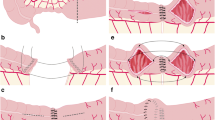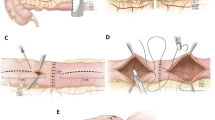Abstract
Primary anastomosis is increasingly favored even in emergency colorectal surgery. Two-stage procedures are frequently considered obsolete. The aim of this study is to define conditions when a two-staged operative strategy with a temporary colostomy is still appropriate. We analyzed a series of 126 patients who were treated by a colostomy following resection and subsequent closure of the colostomy. In 44 cases the primary operation was a Hartmann resection, in 39 cases a resection with colostomy and mucous fistula and in 43 cases a resection with primary anastomosis and proximal loop colostomy. Complications of diverticlar or neoplastic disease were generally managed by resection without primary anastomosis. Protective loop colostomy was done after low anterior resection of the rectum or in cases of anastomotic leakage. Patients were hospitalized again after an average of 6 months for closure of the colostomy. Restoration of intestinal continuity carried no significant risk of severe intra- or postoperative complications. Disturbances of wound healing occurred in 4.5% (Hartmann resection), 17.9% (colostomy and mucous fistula) and 20.9% (loop colostomy) of patients. We found an anastomotic dehiscence rate of 2.4% after discontinuity resections and of 4.7% after closure of loop colostomies. Only one patient with anastomotic leakage required surgical reintervention. The mortality after closure of a colostomy was zero. The rate of anastomotic leakage of 2.4% was lower than in published series with more than 7.2% after primary anastomosis, thus emphasizing the beneficial effect of a two-stage operative strategy. In emergency situations of sigmoidal and rectal surgery or in cases of low anastomosis of the distal rectum, unnecessary surgical complications can be avoided by resection without primary anastomosis or by performing protective loop colostomies.
Zusammenfassung
Die primäre Anastomosierung wird auch bei Notfalleingriffen am Kolon und Rektum zunehmend favorisiert. Zweizeitige Vorgehensweisen werden nicht selten als unzeitgemäß abgetan. Ziel dieser Untersuchung ist es darzustellen, ob und wann die Indikation für ein 2zeitiges Vorgehen mit passagerem Kolostoma auch heute noch gegeben ist. Anhand einer Analyse des eigenen Krankenguts sollen die Ergebnisse der Kolostomieanlage und des Kolostomieverschlusses dargestellt und diskutiert werden. Analysiert wurden 126 Patienten, bei denen Rückverlagerungen eines Kolostomas erfolgten. Bei 44 Patienten ging dem Kolostomieverschluß eine Operation nach Hartmann, bei 39 Patienten eine Diskontinuitätsresektion mit Schleimfistel und bei 43 Patienten die Anlage eines doppelläufigen Kolostomas voraus. Die Diskontinuitätsresektionen wurden fast ausschließlich bei Notfalleingriffen aufgrund von Divertikel- oder Tumorkomplikationen durchgeführt. Die Anlage eines doppelläufigen Kolostomas erfolgte protektiv nach tiefer vorderer Rektumresektion oder bei aufgetretener Anastomoseninsuffizienz. Zum Kolostomieverschluß wurden die Patienten nach durchschnittlich 6 Monaten erneut stationär aufgenommen. Im Rahmen des Kolostomieverschlusses traten keine schwerwiegenden intra- oder postoperativen chirurgischen Komplikationen auf. Bei 4,5% (Hartmann-Operation), 17,9% (Kolostoma und Schleimfistel) und 20,9% (doppelläufiges Kolostoma) der Patienten beobachteten wir Wundheilungsstörungen. Bei Kolostomieverschluß nach Diskontinuitätsresektion wurden nur 2 (2,4%) und nach Rückverlagerung eines doppelläufigen Kolostomas ebenfalls 2 (4,7%) Nahtinsuffizienzen beobachtet, die nur in 1 Fall eine operative Revision erforderlich machten. Kein Patient ist an den Folgen der Kolostomierückverlagerung verstorben. Die Rate an Anastomoseninsuffizienzen war mit 2,4% niedriger als die in der Literatur zu erwartende Rate von mehr als 7.2% nach primärer Anastomosierung, was den Wert eines 2zeitigen Vorgehens unterstreicht. Damit sind die Diskontinutätsresektionen bei Notfalleingriffen am Colon sigmoideum oder Rektum sowie die Anlage eines doppelläufigen Kolostomas bei tiefen Anastomosen im mittleren und unteren Rektumdrittel Verfahren, die helfen, unnötige chirurgische Komplikationen zu verhindern, und damit das Risiko der Operation senken, mit dem Preis höherer Kosten aufgrund eines notwendigen 2. stationären Aufenthalts.
Similar content being viewed by others
Literatur
Allen-Mersh TG (1993) Should primary anastomosis and ontable colonic lavage be standard treatment for left colon emergencies? Ann R Coll Surg Engl 75:195–198
Alanis A, Papanicolaou GK, Tadros RR, Fielding P (1989) Primary resection and anastomosis for treatment of acute diverticulitis. Dis Colon Rectum 32:933–939
Buttenschön K, Büchler M, Vasilescu C, Beger HG (1995) Chirurgischer Strategiewandel bei akuter und komplizierter Colondivertikelerkrankung. Chirurg 66:487–492.
Detry RJ, Kartheuser A, Delriviere L, Saba J, Kestens PJ (1995) Use of the circular stapler in 1000 consecutive colorectal anastomoses: experience of one surgical team. Surgery 117:140–145
Docherty JG, McGregor JR, Akyol M, Murray GD, Galloway DJ, con an behalf of the West of Scotland and Highland anastomosis study group (1995) Comparison of manually constructed and stapled anastomoses in colorectal surgery. Ann Surg 221: 176–184
Dudley HAF, Radcliffe AG, McGeehan D (1980) Intraoperative irrigation of the colon to permit primary anastomosis. Br J Surg 67:80–81
Krawzak H-W, Scherf FG, Hohlbach G (1995) Pumpenassistierte intraoperative Colonlavage. Chirurg 66:1277–1279
Kronborg O (1993) Treatment of perforated sigmoid diverticulitis: a prospective randomized trial. Br J Surg 80:505–507
Morton DG, Keighley MRB (1995) Prospektive nationale Studie zur komplizierten Diverticulitis. Chirurg 66:1173–1176
Mosdell DM, Doberneck RC (1991) Morbidity and mortality of ostomy closure. Am J Surg 162:633–637
Pearce N, Karan SJ (1989) Hartmann's reversal—when and how? (Abstract) Gut 30:1470
Roe AM, Prabhu AA, Brown C, Brodribb AJM (1991) Reversal of Hartmann's procedure: timing and operative technique. Br J Surg 78:1167–1170
Schulz C, Lemmens HP, Weidemann H, Rivas E, Neuhaus P (1994) Die Resektion mit primärer Anastomose bei der komplizierten Diverticulitis. Chrirurg 65:51–53
Shepherd AA, Keighley MRB (1986) Audit on complicated diverticular disease. Ann R Coll Surg Engl 68:8–10
Smith SRG, Connolly JC, Gilmore OJA (1983) The effect of faecal loading on colonic anastomotic healing, Br J Surg 70:49–50
Stewart J, Diament RH, Brennan TG (1993) Management of obstructing lesions of the left colon by resection, on-table lavage, and primary anastomosis. Surgery 114:503–505
Tudor RG, Keighley MRB (1987) The options in surgical treatment of diverticular disease. Surg Annu 19:135–149
Udén P, Blomquist P, Jiborn H, Zederfeldt B (1988) Influence of proximal colostomy on the healing of a left colon anastomosis: an experimental study in the rat. Br J Surg 75:325–329.
Wahl W, Kärcher J, Junginger Th (1992) Therapeutisches Vorgehen bei Komplikationen der Sigmadivertikulitis. In: Bünte H, Junginger Th (Hrsg) Jahrbuch der Chirurgie 1992. Biermann, Zülpich, pp 93–100
Wedell J, Benzhaf G, Mrohs A, Fischer R (1989) Plädoyer für die primäre Resektion mit primärer Anastomose bei der komplizieten Sigmadiverticulitis. Langenbecks Arch Chir 374:259–266
Whiston R, Armitage NC, Hardcastel JD (1989) An appraisal of Hartmann's procedure. Association of surgeons of Great Britain and Ireland, Edinburgh
Wirsching RP, Randenborgh J van (1990) Akute Divertikulitis mit Komplikationen. Munch Med Wochenschr 132:441–444
Author information
Authors and Affiliations
Rights and permissions
About this article
Cite this article
Wahl, W., Hassdenteufel, A., Hofer, B. et al. Passagere Kolostomieanlagen nach Eingriffen am Colon Sigmoideum und Rektum—Sind Sie Noch Gerechtfertigt?. Langenbecks Arch Chiv 382, 149–156 (1997). https://doi.org/10.1007/BF02498668
Received:
Issue Date:
DOI: https://doi.org/10.1007/BF02498668




